論説
 }
}
Introduction
The way we work today is fundamentally different than how we worked a decade ago. Gone are the days when employees would work 9 to 5, Monday to Friday, and only within the four walls of the office. Thanks to leaps in technology, businesses now run 24/7 from anywhere and everywhere.
Flexible workplaces are becoming the norm. Employees are increasingly seeking flexibility in when, where and how they work. This growing demand is rooted in shifts in workforce demographics, accompanied by changing expectations of work-life integration. For example, the percentage of dual-income households in Australia has increased from 40% in 1983 to nearly 60% in 2013.1 We have seen the percentage of working mothers with children under the age of 18 increase by 6% in the past decade.2 The aging population means employees are staying in the workplace longer, often in a more flexible capacity. And the current generation of new recruits, known as millennials, has very different work expectations than their baby boomer parents. Survey after survey has shown what millennials want most is to work flexibly.3
For women, workplace flexibility is especially important. Previous research conducted jointly by Bain & Company and Chief Executive Women (CEW) in 20114 showed that, along with “visible and committed leadership,” women believe “creating working models that support men and women with family responsibilities” to be the most important action to overcoming barriers to women’s progression into leadership roles. Flexibility is especially key for women in junior- and middle-management positions, as they consider whether and how to juggle their career advancement with family aspirations. In the Bain and CEW 2015 research, we found that about 50% of women working flexibly are experienced employees or junior to middle managers, who primarily do so to care for children (see Figure 1). This career stage precedes the dramatic drop in female workforce participation, leading to female executives accounting for less than 15% of senior management positions,5 despite women graduating from universities in greater numbers than men.6 It’s clear that flexible working is a critical enabler to retaining women in the workforce.
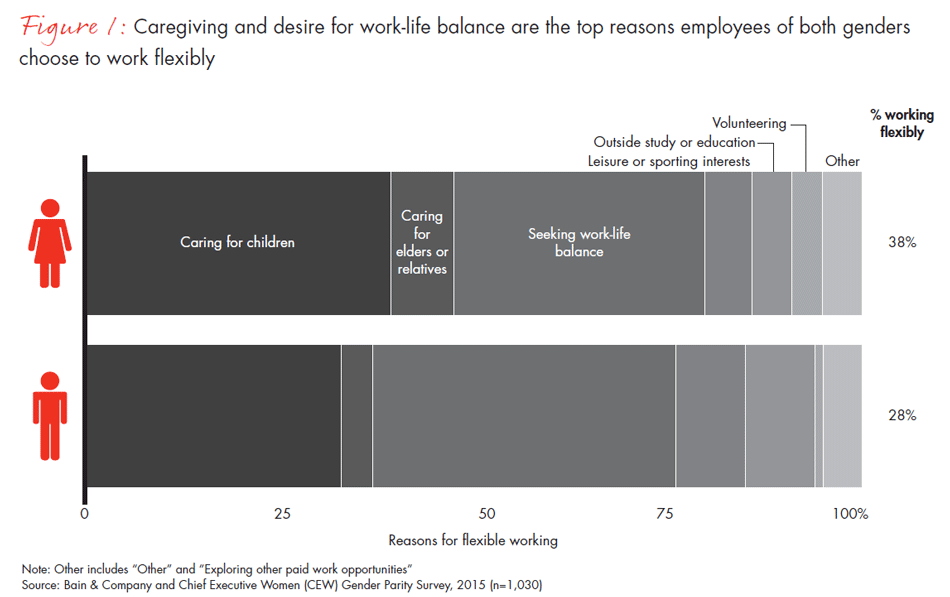
But flexible working is no longer just a women’s issue. Increasingly, men are demanding the ability to work flexibly, often to play more active roles as caregivers. This means the need for successful flexible working models is equally relevant for men. If Australian society really aspires to equal workforce participation by men and women at every level of leadership, then there is a clear imperative to ensure that both genders are equally enabled to share the caregiving role. Men and women therefore need to have equal access and equal success in working flexibly, without negative judgements or repercussions for their career progression.
Australian organisations are increasingly realising that, to retain talent and remain relevant, they need to prepare for a future where flexible work is standard in any role. Thankfully, technology is enabling organisations to shift away from a “face time” culture. In Silicon Valley, organisations like Google are at the cutting edge of this workplace revolution. And, closer to home, companies like Telstra and Westpac are reaping the benefits of championing flexible working and setting their employees up with agile work environments. As David Thodey, former Telstra CEO and member of the Male Champions of Change, points out, management philosophies have not kept up with technological advances. “Every job can be done flexibly. We have the enabling technology, now we need the enabling culture… You need a performance-based culture, where flexibility is just built in.”7
But flexible working is still viewed as the exception to the rule in the majority of Australian companies. Less than 50% of organisations have a workplace flexibility policy.8 And even when such policies exist, they are not always effectively utilised.
So what is the case for flexible working? How successful are Australian organisations at creating positive flexible workplace conditions for both women and men? Most importantly, how can organisations improve their employees’ experiences with flexible working?
To answer these questions, Bain & Company and CEW surveyed 1,030 members of the Australian business, government and not-for-profit community about their use of flexible work arrangements and their perceptions of their organisations. While flexible work can have many meanings, we defined it as an organisation allowing employees a measure of control over when, where and how they work, including working part-time, working from home, setting their own hours and taking a leave of absence.
The good news is there is a powerful case for implementing flexible work arrangements, as they create positive advocacy about the organisation when widely used. This is not surprising: An organisation with flexible arrangements as the norm signals a workplace with progressive policies and actions, and more engaged employees. Furthermore, when we looked at employees utilising flexible arrangements, we found that women working flexibly are stronger advocates of their organisations than those who are not. Our research also debunked the myth that women seeking flexible options have checked out of their careers. We found that women who work flexibly are equally, if not more, committed to reaching their full career potential than those who don’t.
However, the same trends do not hold true for men. In fact, advocacy was lower for men who are or have worked flexibly. This suggests that organisations have not yet cracked the code on how to make such arrangements work for male employees.
To improve employees’ experiences with flexible working models, organisations need to take four actions:
- actively encourage uptake and make working flexibly the standard for every role;
- ensure flexible arrangements are working successfully for both women and men;
- ensure the right culture and active support is in place, with a strong commitment from the CEO and leadership team; and
- provide clear policies, set up enabling technology and create an agile work environment.
If organisations get this right, flexible work arrangements can be used to boost productivity and advocacy, increase employee retention, provide the conditions for increased representation of women in senior leadership positions, and enable men and women to participate more equally as caregivers and secure a better work-life balance.
Bain Partner Melanie Sanders discusses how organisations can get the formula right for women—and men.
1. A strong case for flexible working
So why are organisations like Telstra investing in making flexible workplaces the norm? How strong is the link between flexible work arrangements and employee advocacy? What is the impact of flexible working on employee aspiration and confidence, given it is often viewed as the career slow lane?
To answer these questions, we asked respondents to rate a simple question on a scale of zero to 10: How likely would you be to recommend your organisation as a place to work? Based on respondents’ answers, we calculated a Net Promoter Score®9 (see the sidebar “Net Promoter Score explained” below for more detail): The higher the score, the greater the advocacy levels. We also asked respondents a follow-on question, particularly relevant for our study: How likely would you be to recommend your organisation as a place for women to progress to senior levels?
We found that Net Promoter Scores were significantly higher in organisations where flexible working is widely used than where it is not available (16 vs. negative 44, respectively) (see Figure 2). Our data also suggests that firms benefit from reaching a tipping point when flexible work arrangements become the norm rather than the exception—with the Net Promoter Score increasing significantly from negative 3 when flexibility is rarely used to 16 when it is widely used. This finding is consistent with previous Bain research conducted in the US, which found an equally strong correlation between the adoption of flexible working arrangements and employee advocacy.10
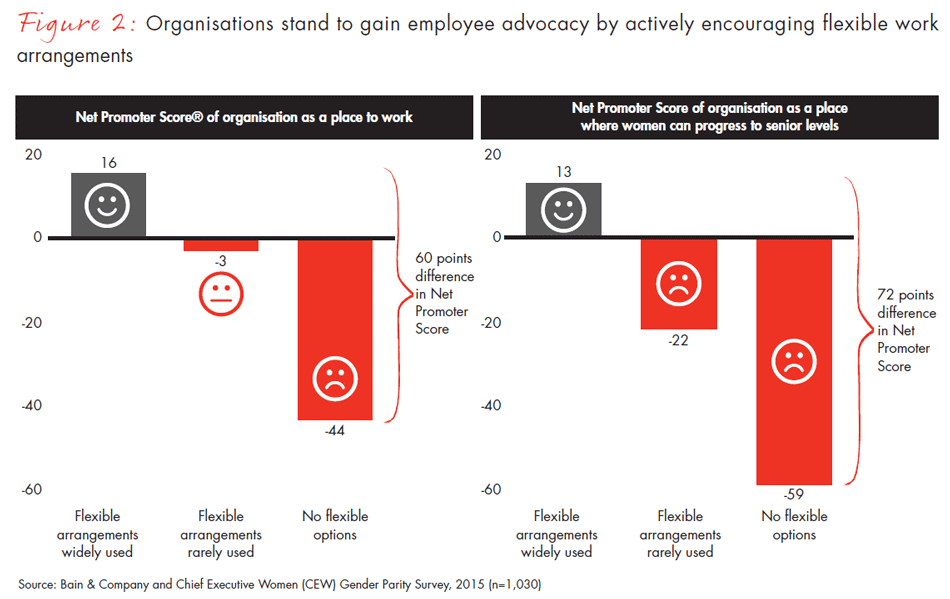
In addition, the Net Promoter Score for the organisation as a place where women can progress to senior levels is significantly higher when flexible working is widely used. Here the difference is even starker, with a 72-point difference between organisations with no flexible arrangements and those where they are widely used (negative 59 vs. 13). It is important to note that organisations where flexible working is available but rarely used also receive a negative Net Promoter Score of negative 22. By actively encouraging flexible arrangements and ensuring they are widely used, organisations stand to gain 35 advocacy points.
As we’ve documented in previous research,11 role models play an important part in convincing employees that working flexibly is a viable option. If women can see successful examples of others progressing while using flexible arrangements, they will be more convinced that their organisation is truly committed to removing barriers to increased gender diversity. The message here is clear: If organisations want to be known for helping women progress to senior levels, they must go beyond simply offering flexible work policies. They must actively encourage and role model the widespread use of flexible working arrangements.
Our research has also debunked the myth that women seeking flexible options are less ambitious. In fact, we found the opposite to be true. Women who work flexibly are equally—if not more—serious and committed to reaching their full career potential than those who don’t (see Figure 3). Furthermore, our findings show that those working flexibly want to advance as far as possible, but they are willing to take different routes to achieve their career goals.
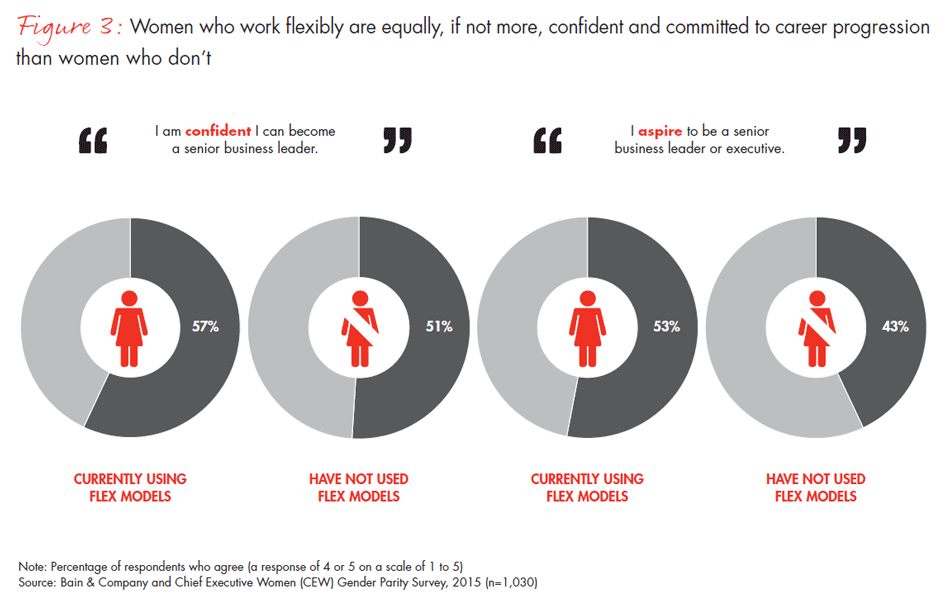
One company that has embarked on the journey of creating a truly flexible workplace is Westpac, and it is already seeing the benefits (see below, “Westpac case study”).
2. Good foundation, but plenty of room for improvement
We’ve seen that where flexible working is widely used, it results in stronger employee advocacy and higher confidence in and aspiration for career advancement in women. To better understand how satisfied employees are with their flexible working, we asked respondents on a scale of one to five: How would you rate your experience with flexible working models at your organisation? What we found was encouraging: Approximately 80% of respondents are satisfied with their experiences (defined as a response of four or five on a five-point scale). Easy-to-access and fair policies, leadership support and improved productivity were the top reasons cited for positive experiences. “[The] company has embraced flex working and it has been a top-down approach, [with] lots of leadership training to prepare,” said one female respondent. A male respondent observed: “The flexible work provisions are clearly available as a policy of the firm, so you are not required to negotiate,” streamlining the process for all. “[Flexibility] enables us to better respond in times of high client demand by getting compensating breaks in times of lower demand,” noted another male respondent, echoing the many survey respondents who cited higher productivity and less stress as prime outcomes of their experience.
But key challenges remain in making flexible working a standard and successful option for all employees.
First, not enough organisations offer and encourage flexible working, and uptake is not yet high enough to unlock the full benefits. Australia’s Workplace Gender Equality Agency found that only 48% of non-public-sector organisations with more than 100 employees have a formal policy in place on flexible working arrangements.12 Furthermore, uptake remains modest: 38% of female respondents and 28% of male respondents use flexible work arrangements, according to our survey. An additional 10% each of male and female respondents are considering flexible work arrangements in the next two years. However, these numbers are likely to be overstated—as we defined flexible working very broadly, and those who chose to respond to our survey are likely to have a higher-than-average interest in flexible working.
Moreover, given the lack of affordable, flexible, accessible or tax-deductible childcare in Australia, availability of flexible options is an even more critical means to enable greater workforce participation for new parents. Approximately 35% of men and women returning to work part-time said that the lack of suitable childcare prevented them from working full-time after parental leave, whereas 22% reported that the availability of flexible options was important in their choice to return to work (see Figure 4). Bolstering childcare options, in conjunction with flexible work options, could significantly help with employee retention and improve the overall productivity of Australia’s workforce.
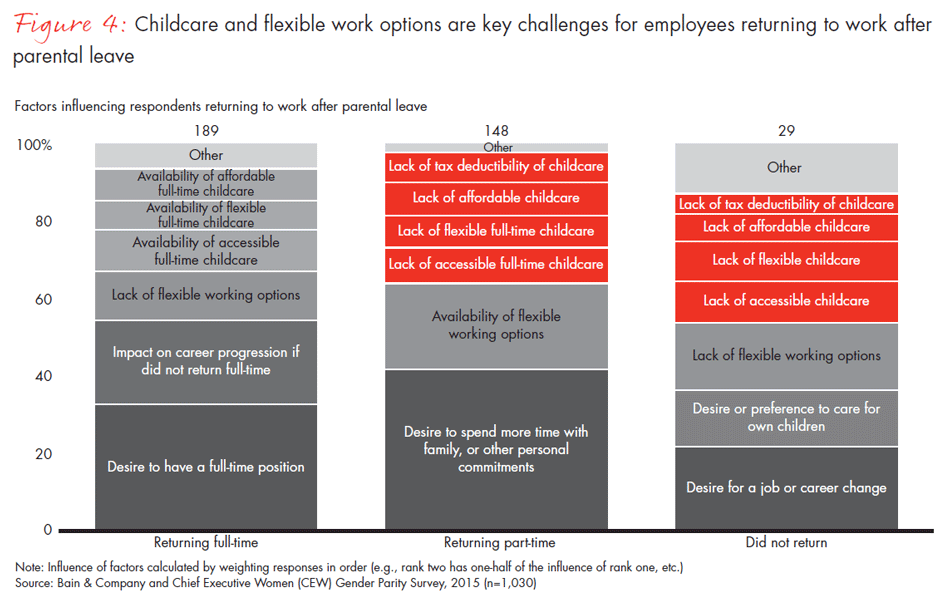
In our survey we also sought to understand the factors behind negative experiences with flexible working. Not surprisingly, women who are not satisfied with flexible working cite facing unrealistic expectations from others as the key issue they face. This is often due to trying to work full-time jobs in part-time roles. “The work doesn’t reduce, just the hours you have to do the work in and the remuneration you receive for doing the work,” noted one respondent. Lack of respect of boundaries when working part-time also was highlighted, with a respondent noting “meetings scheduled without regard to when I’m not working, constant expectation to join on my day at home.” The Net Promoter Score results for different flexible working models support that sentiment (see Figure 5). We find that scores are highest among those working flexible hours and remotely, but are fairly low among those working part-time—who are twice as likely to be female. If organisations want to retain their top female talent, they need to focus on correctly scoping part-time roles and respecting employees’ boundaries.
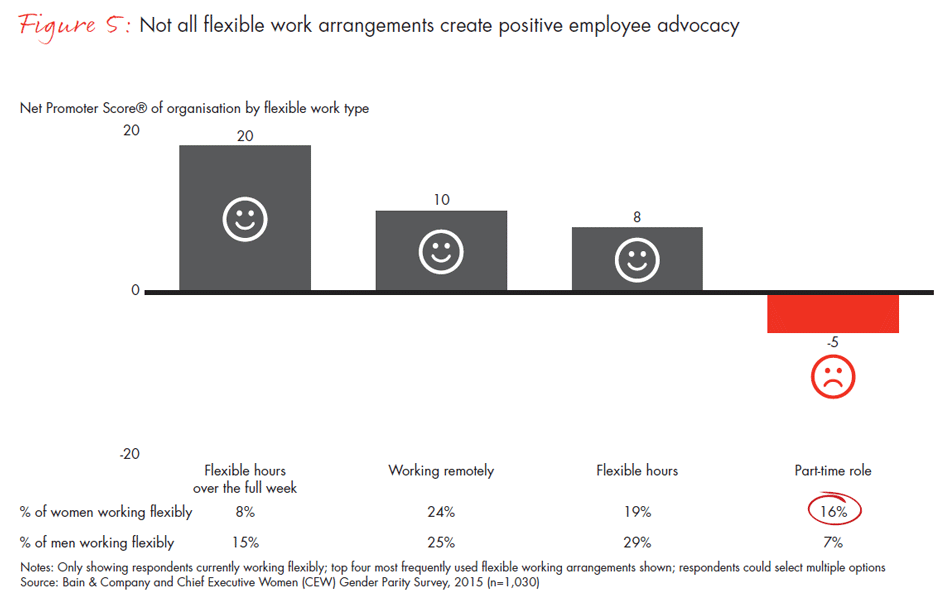
Also concerning is the fact that flexible work arrangements are not driving advocacy or confidence for men, despite strong interest in their uptake. Our research shows that men who work flexibly give their organisation a lower Net Promoter Score than those who don’t (4 vs. 26) (see Figure 6). The reverse trend is true for female employees. Women who use flexible working give higher scores (8 vs. negative 14), and similarly, scores for organisations regarded as places where senior women can progress are also higher (negative 8 vs. negative 34). This could be an indicator that, with men being behind women in their rate of uptake of flexible working, they are suffering the stigmas and biases that women experienced more severely in the early days of their use of flexible working.
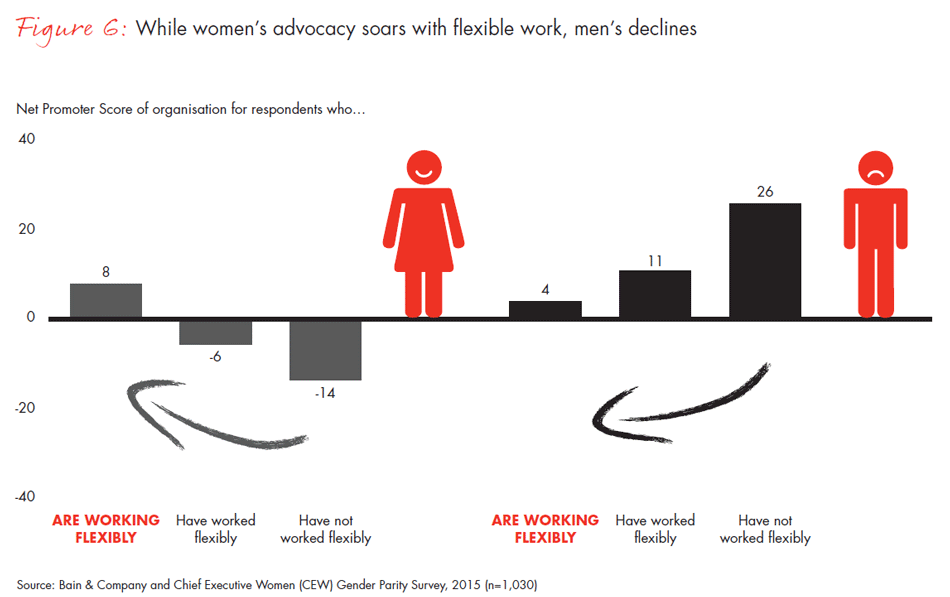
Men who are not satisfied with their flexible working experiences cite as key issues a lack of senior support and the negative view of working flexibly held by their peers and management. “While opportunities exist, the environment that management creates makes it difficult to participate,” said one. Underscoring the cultural challenge, “the arrangements worked as agreed, but I have felt judgement for using them,” said another. In addition, the impact on career progression is stark: “My boss told me I wouldn’t be able to get promoted working part-time,” said another respondent. Recent research by the Australian Human Rights Commission backs this sentiment, finding that 27% of fathers and partners have reported experiencing discrimination related to parental leave and return to work, despite taking very short periods of leave.13 Men are also twice as likely as women to have their request to work flexibly rejected.14 A manager told one respondent seeking flexible arrangements that “part-time is traditionally only something we make work for women”. To break the stigma and negative sentiment associated with men working flexibly, organisations need to demonstrate commitment, from the CEO level down, to making flexible working the norm for both genders.
We see the same gender-specific trends when we look at confidence and aspiration. While our survey showed that women respondents who work flexibly are more confident and committed to career progression than those who don’t, the story is different for men. Confidence and commitment levels are in fact lower for men who work flexibly than those who don’t (see Figure 7). Again, this is potentially a result of the perception challenges they face.
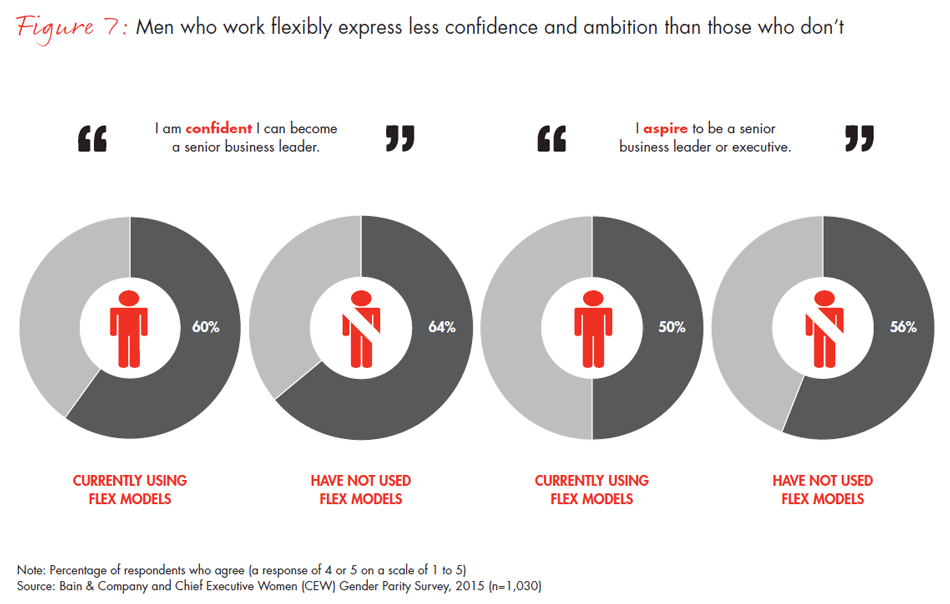
Until we see flexible working being embraced by and working successfully for both men and women, social norms regarding the roles of both genders will remain entrenched. Given this, it’s essential that organisations challenge the notion of a linear career, as well as an office-based working life. Companies need to promote and support top performers who take alternative career paths by working flexibly. Highlighting such examples will help convince the doubters of the benefits to both the employer and employee of working flexibly, as well as demonstrate that top leaders within the organisation strongly support those alternatives. To enable this, companies need to provide access to quality flexible work options that are correctly scoped and actively supported.
3. Four key actions to leverage flexible working
To normalise and accelerate flexible work arrangements, organisations need to take four key actions:
- Actively encourage and role model the uptake of flexible work arrangements and make them standard for every role, including the most senior roles. Simply offering flexibility is not enough; the tipping point in employee advocacy comes when flexible arrangements are widely used.
- Ensure flexible arrangements are working successfully for both genders. Approximately 60% of men surveyed are, have or want to work flexibly, but so far uptake is not driving advocacy, in contrast with the clear trend we observed with women. Organisations that promote flexible models for both men and women will signal a culture that embraces different working styles and is outcome-oriented (rather than a face time culture). Such companies are more likely to make it work for everyone. As Craig Meller, CEO of AMP, points out: “The need for flexible work is gender-neutral—it has significant advantages for men, women, organisations and economies alike. Normalising flexible work opens up new sources of talent and new ways of operating, and this is key to being an innovative and agile business”. It is only by ensuring that flexible arrangements work for men and women that we will change entrenched gender norms in Australia, retain the best talent in our workforce and increase our overall productivity.
- Most important, the right culture and active support need to be in place. When asked what factors would be most important in improving employees’ experience with flexible working, male and female respondents agreed on the top reasons: proof of the potential to progress one’s career; visible commitment from the CEO, the leadership team and colleagues; and respect of boundaries (see Figure 8). Only if these are in place will employers benefit from the improvement in employee engagement and productivity.
- And finally, organisations must ensure the right policies, technology and agile work environment are in place and working well. It’s essential that organisations provide clear policies (such as how compensation and promotion decisions are handled when working flexibly) and enablers (such as technology for remote working, ability to work from multiple locations and provisions for childcare). It is also essential that leaders throughout an organisation are equipped and empowered to implement flexible working in ways that enhance their organisation’s agility.
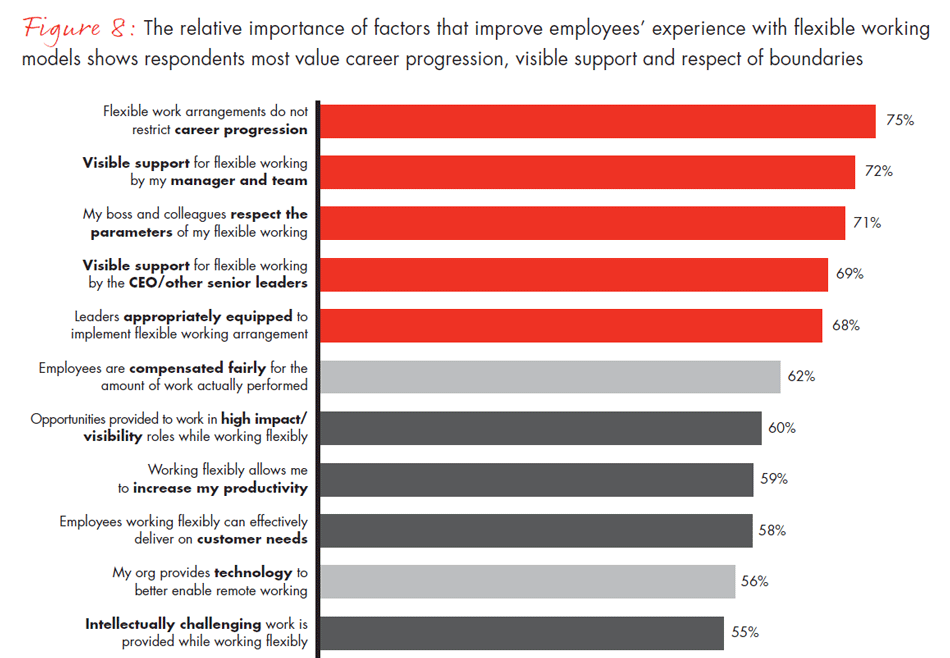
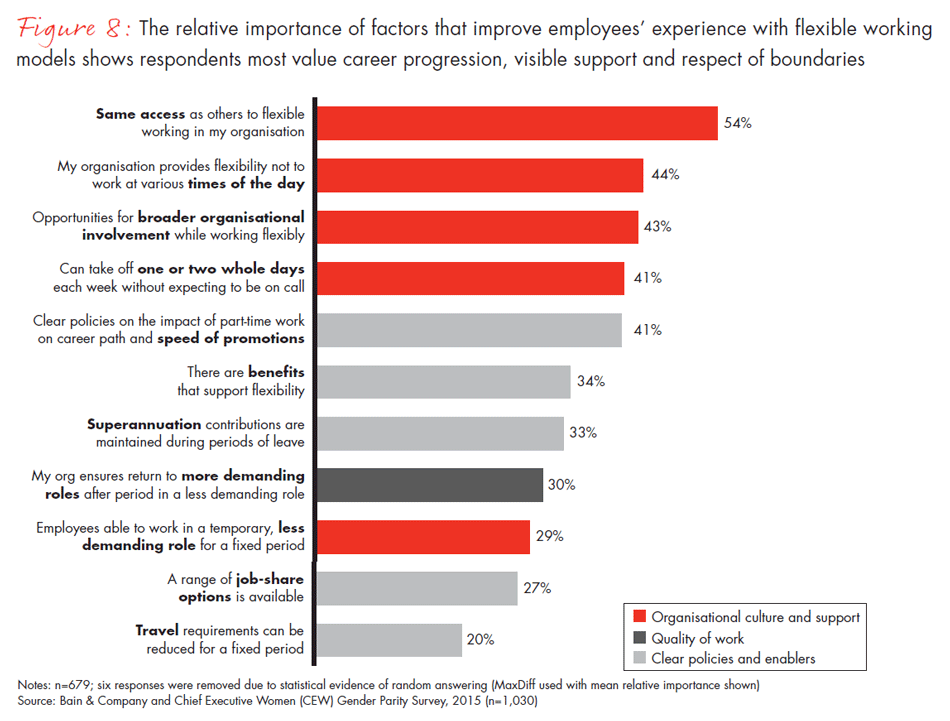
Telstra is reaping significant benefits from having taken concrete actions to embed flexible working practices into their business (see below, “Telstra case study”).
For all organisations seeking to raise their game on flexible working models, asking the following questions could be a good place to start.
Is your organisation set up for flexible working?
- Do we understand the commercial imperative (including productivity, retention and engagement benefits) for flexible working in our organisation?
- Is there demonstrated commitment from the leadership team to flexible working (e.g., public statement from the CEO, all jobs advertised as being flexible, role modelling of flexible working amongst the leadership group)?
- Have we challenged the design of each role to ensure it can be performed flexibly?
- Are high-impact, challenging roles developed for employees working flexibly?
- Is a flexible working onboarding process and training set up for employees and managers?
- Is there a formal check-in process for each employee working flexibly (e.g., mentor assigned to check in every two months, scheduled reviews of workload and expectations to manage sustainability)?
- Is there formal, measurable feedback to assess office-wide progress (e.g., annual survey)?
- Are lessons learned codified and shared (e.g., organised experience sharing, online support platform)?
- Are men and women working flexibly celebrated (e.g., forum where men working flexibly share their experiences, participation in the Equilibrium Challenge)?
- Are promotions of men and women who work flexibly celebrated?
- Is the technology set up to enable employees to work from anywhere (e.g., from home or other office locations)?
- Are policies regarding benefits, promotion processes, etc., clearly defined and communicated?
Our research shows that organisations in Australia stand to benefit from offering and encouraging the uptake of flexible work arrangements. We found that working flexibly is associated with higher employee advocacy and ambition among women. We are confident that, with the right support and increased uptake, organisations will obtain similar outcomes from men. By encouraging women and men to reach their full potential through flexible work, organisations create a positive cycle and boost employee advocacy and productivity.
Australian organisations have built some good foundations for a flexible workforce. What is now required to unlock the potential productivity benefits of flexible working is a strong commitment from business leaders, changes in community attitudes and relevant policies from governments. The obstacles that remain are surmountable, and the potential benefits significant.
Westpac has introduced a range of flexible working practices and policies as part of its longstanding commitment to flexibility. This focus has cemented flexibility as one of Westpac’s cornerstone people strategies, driving workforce participation, progression and productivity. As a result, more than 63% of Westpac employees now work flexibly. Importantly, flexibility is viewed as a crucial enabler of gender equity and Westpac’s commitment to their Women in Leadership target of 50% by 2017.
Taking flexibility to the next level
Reinforcing Westpac’s ambition to take its flexibility agenda to the next level, the bank launched its “All in Flex” campaign in June 2015, which ensures all 40,000 existing roles globally are considered for flexible working, as well as any new roles created. This was in response to the insight that 89% of their employees (both male and female) indicated they would need some form of flexibility in the next three years, a more than 25% increase on current participation rates.
“The way I see it, flexibility helps people achieve their full potential by removing barriers to success. If people have the flexibility to manage their personal commitments, they are more likely to bring their whole selves to work every day. And that means they’re more likely to do their best work and exceed customer expectations,” says Brian Hartzer, Westpac Group CEO.
Westpac now requires people leaders to be overt and proactive about flexibility conversations with their teams. As part of the change, people leaders are required to do five key things to encourage a more flexible workforce:
- Make yes the default answer;
- Put flexibility on the agenda at team meetings;
- Understand the flex options and resources available;
- Raise flexibility as a key benefit; and
- Role model flexibility.
“Critical to a change management program of this size is senior leader role modelling and executive commitment as well as supporting tools, resources and infrastructure for People Leaders and employees,” says Ainslie van Onselen, Director of Women’s Markets, Diversity and Inclusion at Westpac Group.
Workplace design supporting flexibility
An additional component of Westpac’s flexibility journey is its physical shift to agile and activity-based working environments, with more than 10,000 employees in the corporate offices of Sydney, Melbourne and Brisbane working in an agile environment. To support this journey, Westpac instituted the WorkSMART program. WorkSMART is both a way of working that empowers people to choose how, when and where they work, and a transformation program charged with overhauling Westpac’s corporate environment, technology, tools, systems and policies to create a culture where work is no longer a place you go—but something you do and achieve.
The purpose of “All Roles Flex” was to adopt a new, disruptive position to mainstream flexibility and thereby amplify the productivity benefits, lift engagement, improve gender balance, enable flexibility for all Telstra people (not just promote it as an issue for women), and establish a clear market proposition, with technology linked very strongly to enabling this.
Telstra began by understanding the evidence that it was missing out on the well-documented benefits of working more flexibly. Early on, visible senior level and CEO support to make “All Roles Flex” was secured. Telstra next undertook a three-month pilot of the “All Roles Flex” approach in a large (9,000 staff) business unit, focusing on recruitment and manager education. Results were compelling. Female representation among offers accepted increased from 37% to 50%, and 30% of those recruited applied for the role because of Telstra’s openness about flexibility.
Today, flexibility is the starting point for working at Telstra. The focus is on outcomes, not face time, and Telstra uses technology, workplace design and new attitudes to support how employees work. All Telstra’s advertised jobs have the designation “flexible” and say: “We work flexibly at Telstra. Talk to us about how this job could be flexible for you.” This invitation is supported by a flexibility discussion with recruiters and each hiring manager. In addition, Telstra is focused on ongoing, localised coaching for leaders around the business case for and benefits of flexibility, setting clear guidelines for how leaders should assess requests and encouraging the sharing of both challenges and positive cases of flexibility through a “crowd support” group on the internal online Yammer platform.
In September 2013, Telstra announced “All Roles Flex” would be adopted throughout Telstra by the end of March 2014. Today, the hallmarks of “All Roles Flex” are evident, including:
- Applying advanced technology like video conferencing as standard practice, smartphone technology for all employees, and a new attitude to flexibility;
- Flexibility as a real component of team and individual discussions around performance planning and expectations, and performance evaluation; and
- Involvement in programs such as the Workplace Gender Equality Agency’s Equilibrium Man Challenge, creating new norms around men and flexibility.
Thanks to “All Roles Flex”, 84% of employees agree that they are able to access the flexibility they need to balance work and personal life, an increase of 4% from 2013. Telstra has also seen sustained improvements in terms of gender equality as a result of its openness to and enablement of more flexible ways of working. Some examples include:
- Female representation among commencements is at 42.9%, up from 36.7% for the same period last year;
- The number of women joining Telstra exceeds the number of women leaving for the eighth successive quarter, ending a retention issue that had persisted for some time;
- Accompanying Telstra’s high rates of parental leave return and retention (higher than 90%), the number of male managers at Telstra taking primary parental leave increased threefold in the past year from 0.8% to 2.3%—an insight into shifting culture, and a new norm around men and flexibility at Telstra.
Methodology
We received 1,030 responses from employees of large and small Australian businesses, government and not-for-profit organisations. Of the respondents, 58% were women and 42% were men; 44% held senior management, executive or board positions.
Melanie Sanders is a partner with Bain & Company. She leads Bain’s Consumer Products and Retail practice for Australia and New Zealand. Jennifer Zeng is a partner with Bain & Company. She leads Bain’s M&A practice for Australia and New Zealand. Meredith Hellicar is a member of Chief Executive Women (CEW), principal of Merryck & Company and a Non-Executive Director, formerly having a range of CEO roles in resources, logistics, professional and financial services in Australia and Asia. Kathryn Fagg is a member of CEW and is a Non-Executive Director, having previously led businesses in logistics, manufacturing and banking in Australia, New Zealand and Asia. She is a board member of the Reserve Bank of Australia.
The authors would like to recognise Shannon McFadden (Manager) and Nicole Kuepper-Russell (Consultant) with Bain & Company, who made significant contributions to the 2015 Gender Parity research.
1 Rebecca Cassells, Mathew Toohey, Marcia Keegan and Itismita Mohanty, “Modern Family; The Changing Shape of Australian Families”, AMP.NATSEM Income and Wealth Report, no. 34 (October 2013): 25, accessed October 19, 2015, www.natsem.canberra.edu.au/publications/?publication=modern-family-the-changing-shape-of-australian-families.
2 Based on Australian census data: 58.9% of mothers with children under the age of 18 were employed in 2001, compared with 65.2% in 2011 (the latest census data). Jennifer Baxter, “Parents Working Out Work”, Australian Family Trends, no. 1 (April 2013), Australian Government’s Institute of Family Studies, https://aifs.gov.au/publications/parents-working-out-work.
3 Brigid Schulte, “Millennials Want a Work-Life Balance. Their Bosses Just Don’t Get Why”, The Washington Post, May 5, 2015, accessed October 19, 2015, www.washingtonpost.com/local/millennials-want-a-work-life-balance-their-bosses-just-dont-get-why/2015/05/05/1859369e-f376-11e4-84a6-6d7c67c50db0_story.html.
4 Melanie Sanders, Jayne Hrdlicka, Meredith Hellicar, Dale Cottrell and Joanna Knox, “What Stops Women From Reaching the Top? Confronting the Tough Issues”, Bain Brief, November 2011, http://www.bain.com/offices/australia/en_us/publications/what-stops-women-from-reaching-the-top.aspx.
5 According to Chief Executive Women’s CEO database, as at June 2015, just 6% of CEOs of ASX 200 companies are women. Also, women make up only 13% of Key Management Personnel of ASX200 companies BlackRock, “Achieving Gender Diversity in Australia: The Ugly, the Bad and the Good”, April 2015, accessed October 19, 2015, www.blackrock.com/au/individual/literature/whitepaper/achieving-gender-diversity-in-australia-en-au.pdf.
6 Women represent 58% of university graduates Australian Bureau of Statistics, “Attainment of Bachelor’s Degree or above, 25-29 Years”, Gender Indicators: Education, August 2015, accessed October 19, 2015, http://www.abs.gov.au/ausstats/abs@.nsf/Lookup/by%20Subject/4125.0~Aug%202015~Main%20Features~Attainment~6153.
7 EY, “What Should Organisations Do Differently? In His Own Words: Women in Leadership”, accessed October 19, 2015, www.ey.com/AU/en/About-us/Our-people-and-culture/Diversity-and-inclusiveness/EY-women-in-leadership-report-in-his-own-words-what-should-organisations-do-differently.
8 Workplace Gender Equality Agency, “Australia’s Gender Equality Scorecard”, November 2014, accessed October 19, 2015, www.wgea.gov.au/sites/default/files/2013-14_summary_report_website.pdf.
9 Net Promoter Score® is a trademark of Bain & Company, Inc., Fred Reichheld and Satmetrix Systems, Inc.
10 Julie Coffman and Russ Hagey, “Flexible Work Models: How to Bring Sustainability to a 24/7 World”, Bain Report, October 2010, www.bain.com/publications/articles/flexible-work-models-how-to-bring-sustainability-to-24-7-world.aspx.
11 Melanie Sanders, David Zehner, Kathryn Fagg and Meredith Hellicar, “Creating a Positive Cycle: Critical Steps to Achieving Gender Parity in Australia”, Bain Report, February 2013, www.bain.com/offices/australia/en_us/publications/creating-a-positive-cycle.aspx
12 Workplace Gender Equality Agency, “Australia’s Gender Equality Scorecard”, November 2014, accessed October 19, 2015, www.wgea.gov.au/sites/default/files/2013-14_summary_report_website.pdf
13 Australian Human Rights Commission, “Supporting Working Parents: Pregnancy and Return to Work National Review – Report”, (2014):23, accessed October 19, 2015, https://www.humanrights.gov.au/sites/default/files/document/publication/SWP_Report_2014.pdf.
14 “Creating More Gender Equal Workplaces”, EquilibriumChallenge, July 2015, accessed October 19, 2015, http://equilibriumchallenge.com.au/site/?p=1815.
